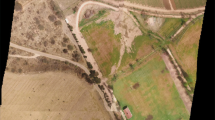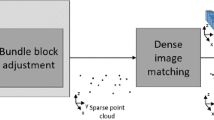Abstract
Unmanned aerial systems (UAS) have been used as a robust tool for agricultural and environmental applications in recent years. Remote sensing systems based on UAS typically acquire massive hyper-spatial images in its short turnaround. This paper takes advantage of graphics processing unit (GPU) massive parallel computation in order to process the huge data timely and efficiently. More specifically, this paper presents an index array approach for lens distortion correction and geo-referencing. They are the two essential components in UAS hyper-spatial image processing. The index array approach is also capable of parallelizing image file I/O and the orthoimage generation. In addition, this paper presents the dual tiled similarity algorithm for the image co-registration. The index array approach and the dual tiled similarity algorithm were evaluated using two UAS remote sensing datasets of South Padre island shorelines. The results show that this index array approach was able to speed up at least 10 times the lens distortion correction and the geo-referencing relative to the central processing unit (CPU) computation. This dual tiled algorithm could provide 12 times speedup compared with the CPU similarity computation.








Similar content being viewed by others
References
FAA, Unmanned Aircraft Systems (UAS) - Regulations & Policies, 2011, http://www.faa.gov/about/initiatives/uas/reg/
Christophe E, Michel J, Inglada J (2011) Remote sensing processing: from multicore to GPU. IEEE J Sel Top Appl Earth Obs Remote Sens 4(3):643–652
Lee CA, Gasster SD, Plaza A, Chang C, Huang B (2011) Recent developments in high performance computing for remote sensing: a review. IEEE J Sel Top Appl Earth Obs Remote Sens 4(3):508–527
Setoain J, Prieto M, Tenllado C, Plaza A, Tirado F (2007) Parallel morphological endmember extraction using commodity graphics hardware. IEEE Geosci Remote Sens Lett 4(3):441–445
Yang H, Du Q, Chen G (2011) Unsupervised hyperspectral band selection using graphics processing units. IEEE J Sel Top Appl Earth Obs Remote Sens 4(3):660–668
Luo Y, Guo K, Zhao S, Tao Z, Wang M (2012) Feature extraction of hyperspectral remote sensing in parallel computing research based on GPU. In Proceedings of the 4th GEOBIA, pp. 381–384, May, Rio de Janeiro, Brazil
Trigueros-Espinosa B, Velez-Reyes M, Santiago NG, Rosario-Torres S (2012) Evaluation of the graphics processing unit architecture for the implementation of target detection algorithms for hyperspectral imagery. Journal of Applied Remote Sensing, Vol.6, No.1, 061506 (Jun 21). doi: 10.1117/1.JRS.6.061506
Gonzalez C, Sanchez S, Paz A, Resano J, Mozos D, Plaza A (2013) Use of FPGA or GPU-based architectures for remotely sensed hyperspectral image processing. Integr VLSI J 46:89–103
Qu H, Zhang J, Lin Z, Chen H (2013) Parallel Acceleration of SAM Algorithm and Performance Analysis. IEEE J Sel Top Appl Earth Obs Remote Sens 6(3):1172–1178
Molero JM, Garzon EM, Garcia I, Quintana-Orti ES, Plaza A (2014) Efficient implementation of hyperspectral anomaly detection techniques on GPUs and multicore processors. IEEE J Sel Top Appl Earth Obs Remote Sens 7(6):2256–2266
Nascimento JMP, Bioucas-Dias JM, Alves JMR, Silva V, Plaza A (2014) Parallel hyperspectral unmixing on GPUs. IEEE Geosci Remote Sens Lett 11(3):666–670
Wu X, Huang B, Plaza A, Li Y, Wu C (2014) Real-time implementation of the pixel purity index algorithm for endmember identification on GPUs. IEEE Geosci Remote Sens Lett 11(5):955–959
Dai C, Yang J (2011) Research on orthorectification of remote sensing images using GPU-CPU cooperative processing. In Proceedings of IGARSS 2011. July, Vancouver, Canada
Reguera-Salgado J, Calvino-Cancela M, Martin-Herrero J (2012) GPU geocorrection for airborne pushbroom imagers. IEEE Trans Geosci Remote Sens 50(11):4409–4419
Lemoine G, Giovalli M (2013) Geo-correction of high-resolution imagery using fast template matching on a GPU in emergency mapping contexts. Remote Sens 5:4488–4502. doi:10.3390/rs5094488
Zhang W, Li Y, Li D, Teng C, Liu J (2014) Distortion correction algorithm for UAV remote sensing image based on CUDA. 35th International Symposium on Remote Sensing of Environment (ISRSE35), IOP Conference Series: Earth and Environmental Science, vol.17
Fang L, Wang M, Li D, Pan J (2014) CPU/GPU near real-time preprocessing for ZY-3 satellite images: relative radiometric correction, MTF compensation, and geocorrection. ISPRS J Photogramm Remote Sens 87:229–240
Lei Z, Wang M, Li D, Lei TL (2014) Stream model-based orthorectification in a GPU cluster environment. IEEE Geosci Remote Sens Lett 11(12):2115–2119
Su X, Wu J, Huang B, Wu Z (2013) GPU-accelerated computation for electromagnetic scattering of a double-layer vegetation model. IEEE J Sel Top Appl Earth Obs Remote Sens 6(4):1799–1806
Coleman DM, Feldman DR (2013) Porting existing radiation code for GPU acceleration. IEEE J Sel Top Appl Earth Obs Remote Sens 6(6):2486–2491
Fulkerson B, Soatto S (2012) Really quick shift: Image segmentation on a GPU. Trends and Topics in Computer Vision. Springer, Berlin, pp 350–358
Happ PN, Feitosa RQ, Bentes C, Farias R (2013) A region-growing segmentation algorithm for GPUs. IEEE Geosci Remote Sens Lett 10(6):1612–1616
Bernabe S, Plaza A, Marpu PR, Benediktsson JA (2012) A new parallel tool for classification of remotely sensed imagery. Comput Geosci 46:208–218
Wolf P, DeWitt B (2000) Elements of photogrammetry with applications in GIS (3rd Edition). McGraw-Hill, New York
(2013) Intergraph, ERDAS Field Guide
Lillesand T, Kiefer RW, Chipman J (2007) Remote sensing and image interpretation (6th Edition). Wiley, New York
Maune DF (2007) Digital elevation model technologies and applications: the DEM users manual. The American Society for Photogrammetry and Remote Sensing
Shan J, Toth CK (2008) Topographic laser ranging and scanning: principles and processing. CRC
Turner D, Lucieer A, Malenovsky Z, King DH, Robinson SA (2014) Spatial co-registration of ultra-high resolution visible, multispectral and thermal images acquired with a micro-UAV over antarctic moss beds. Remote Sens 6(5):4003–4024. doi:10.3390/rs6054003
Mikolajczyk K, Schmid C (2005) A performance evaluation of local descriptors. IEEE Trans Pattern Anal Mach Intell 27(10):1615–1630
(2014) Kolor Autopano, Version 1.4.0. Autopano website http://www.autopano.net
Laliberte AS, Herrick JE, Rango A, Winters C (2010) Acquisition, orthorectification, and object-based classification of Unmanned Aerial Vehicle (UAV) imagery for rangeland monitoring. Photogramm Eng Remote Sens 76(6):661–672
Du Q, Raksuntorn N, Orduyilmaz A, Bruce LM (2008) Automatic registration and mosaicking for airborne multispectral image sequences. Photogramm Eng Remote Sens 74(2):169–181
Mitchell HB (2010) Image fusion theories, Techniques and applications. Springer, New York
Morton RA, Peterson RL, South Texas Coastal Classification Maps - Mansfield Channel to the Rio Grande, USGS Open File Report 2006–1133. http://pubs.usgs.gov/of/2006/1133/mapintro.html Accessed 21 Oct 2015
Kirk DB, Hwu WW (2010) Programming massively parallel processors, a hands-on approach. Elsevier, New York
Acknowledgments
This work was supported partly by the NSF grant MRI: Acquisition of a High Performance Computing Cluster to Support Multidisciplinary Big Data Analysis and Modeling (#1429518).
Author information
Authors and Affiliations
Corresponding author
Rights and permissions
About this article
Cite this article
Su, L., Huang, Y., Gibeaut, J. et al. The index array approach and the dual tiled similarity algorithm for UAS hyper-spatial image processing. Geoinformatica 20, 859–878 (2016). https://doi.org/10.1007/s10707-016-0253-2
Received:
Revised:
Accepted:
Published:
Issue Date:
DOI: https://doi.org/10.1007/s10707-016-0253-2




